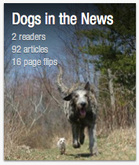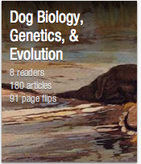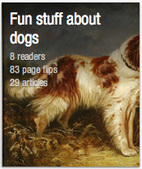We know that the expression of a gene can be modified by other genes. Now a study has shown that the effect of the modifier gene depends on the genome it's in As you peer over the results of a battery of genetic tests done on your dog, you might need to consider that what they actually mean is a whole lot different than you think. The mutation in one dog might cause disease, but in another dog it doesn't. One dog responds to treatment, the other doesn't. You decide based on phenotype that one dog has a gene and another doesn't, but in fact they both do. A combination of genes can have one effect (positive?) in one dog, and a completely different (negative?) one in another. Bottom line - it's potentially really, really complicated. Wow.
You can read more here, and there's an excerpt from the abstract of the paper below.
You can read more here, and there's an excerpt from the abstract of the paper below.
"The phenotypic outcome of a mutation cannot be simply mapped onto the underlying DNA variant. Instead, the phenotype is a function of the allele, the genetic background in which it occurs and the environment where the mutational effects are expressed.
While the influence of genetic background on the expressivity of individual mutations is recognized, its consequences on the interactions between genes, or the genetic network they form, is largely unknown. The description of genetic networks is essential for much of biology; yet if, and how, the topologies of such networks are influenced by background is unknown. Furthermore, a comprehensive examination of the background dependent nature of genetic interactions may lead to identification of novel modifiers of biological processes. Previous work in Drosophila melanogaster demonstrated that wild-type genetic background influences the effects of an allele of scalloped (sd), with respect to both its principal consequence on wing development and its interactions with a mutation in optomotor blind. In this study we address whether the background dependence of mutational interactions is a general property of genetic systems by performing a genome wide dominant modifier screen of the sdE3 allele in two wild-type genetic backgrounds using molecularly defined deletions. We demonstrate that ~74% of all modifiers of the sdE3 phenotype are background-dependent due in part to differential sensitivity to genetic perturbation. These background dependent interactions include some with qualitative differences in the phenotypic outcome, as well as instances of sign epistasis. This suggests that genetic interactions are often contingent on genetic background, with flexibility in genetic networks due to segregating variation in populations. Such background dependent effects can substantially alter conclusions about how genes influence biological processes, the potential for genetic screens in alternative wild-type backgrounds identifying new loci that contribute to trait expression, and the inferences of the topology of genetic networks."
Chari, S & I Dworkin 2013 The Conditional Nature of Genetic Interactions: The Consequences of Wild-Type Backgrounds on Mutational Interactions in a Genome-Wide Modifier Screen. PLoS Genet 9(8): e1003661. doi:10.1371/journal.pgen.1003661
 RSS Feed
RSS Feed





